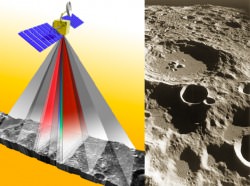The Moon is going to be a busy place. NASA is sending the Lunar Reconnaissance Orbiter in 2008, and will be sending humans back as early as 2020. Germany, a member of the European Space Agency, announced they’ll be getting in the lunar game too. Their recently announced Lunar Exploration Orbiter will be heading to the Moon in 2012, giving our satellite another satellite of its own.
The new details on the Lunar Exploration Orbiter were announced at the European Planetary Science Congress, which is being held this week in Potsdam.
The mission will consist of two spacecraft flying in formation, and taking simultaneous measurements of the lunar surface. As with NASA’s Stereo mission, targeted at the Sun, this twin vision will give scientists a true stereoscopic view of the Moon’s surface features. The Moon, in thrilling 3-D!
It will also be able to study the Moon’s magnetic and gravitational fields in 3 dimensions as well, both on the near side, and the far side of the Moon. The main satellite will weigh about 500 kg (1100 pounds), and the secondary satellite will only weigh about 150 kg (330 pounds), carrying duplicate magnetic and gravity instruments.
The main satellite carries a microwave radar that will allow it to peer beneath the lunar surface to a depth of several hundred metres. At maximum depths, it’ll be able to resolve structures two metres across, and within the top few metres, it’ll be able to resolve structures just a few millimetres across. This will help scientists track the distribution of rocks and particles, and help reveal the history of impacts.
LEO will create high resolution maps of the entire lunar surface in stereo and multispectral bands. The whole mission should last 4 years, so it will even be able to watch for new impacts, by looking for new craters and detecting impact events. That should be pretty impressive.

